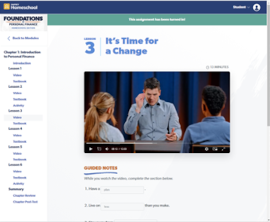The Foundations in Personal Finance, Homeschool Edition course was created by Ramsey Education, a company founded by Dave Ramsey, who has been providing instruction in personal finances for decades. This online course for homeschoolers uses a combination of videos, notetaking, an online textbook (a printed textbook is available), written responses, and activities. Students should be able to complete the course in one semester, earning a half credit in economics or as an elective. Parents set up the course with their own access as well as access for their student(s) so they can track progress.
The course consists of 13 modules, and each module has four to six lessons plus an introduction, a chapter review, and a chapter test..
The modules are titled:
- Introduction to Personal Finance
- Budgeting Basics
- Saving Money
- Credit and Debt
- Consumer Awareness
- Career Readiness
- College Planning
- Financial Services
- The Role of Insurance
- Income and Taxes
- Housing and Real Estate
- Investing and Retirement
- Global Economics
Each lesson has a video that runs from about 7 to 13 minutes. The videos reflect high production values with multiple camera angles and different settings and formats. They are hosted primarily by George Kamel and feature other speakers from Dave Ramsey’s company, including Dave Ramsey himself. These speakers sometimes spend a significant part of a presentation in a discussion with small groups of students, making the lessons relatable to teens as participants bring up their own thoughts and experiences.
The videos are accompanied by guided notes on the screen below the video, and students need to fill in the guided notes while they watch. (Lines relating to the notes are highlighted on the screen when they are spoken, so it’s easy to fill these in just by paying attention.) The guided notes are followed by one or two questions that students answer online with a sentence or two. The guided notes are graded and the scores are tracked by the program. However, I entered nonsense for many of the final questions with non-predictable answers, and it didn’t detract from my scores. Parents can view students' written responses from their own dashboard, but I don't see any options for making comments or grading them. (The program simply marks them as completed if anything is written in the block.) Consequently, parents might want to discuss those questions with students rather than having them write answers without getting any feedback.
The online textbook includes illustrations and occasional infographics—it’s very readable. The content usually repeats some of what was in the lesson’s video but includes more. Students really can’t choose to use only the video or only the textbook.
There are two activities within each module. These include downloadable PDFs and require written work. The activities have students start to put what they learn into action with introspection, research, planning, and written goals. They vary greatly in their formats. For instance, in the first module, one activity has students answer six, short-essay questions, then research four government programs related to finance. The second activity in this module has students interview a trusted adult about money habits, goals, and views, using questions on the PDF. The activities will need to be evaluated offline by parents.
While all speakers on the videos direct their remarks to students in traditional educational settings, with occasional references to guidance counselors and participation in school activities, homeschoolers can still apply almost everything. In fact, homeschoolers usually have the advantage of greater flexibility than those in traditional schools. For instance, they often have access to more varied community involvement and activities than do others because of flexible schedules. Also, homeschoolers tend to take greater advantage of dual credit and testing for college credit which is discussed briefly in the seventh module on college planning.
Summary
Foundations in Personal Finance, Homeschool Edition covers a wide range of valuable content, and it’s extremely well presented. While it does not concentrate on macroeconomics as much as most high school economics course (e.g., topics such as monetary policies and supply and demand), what it does cover might be more practical and relevant to students.








